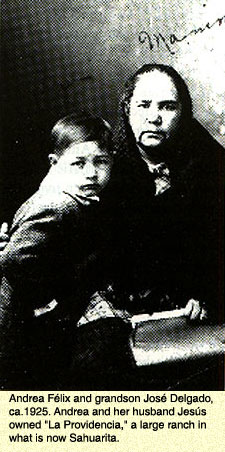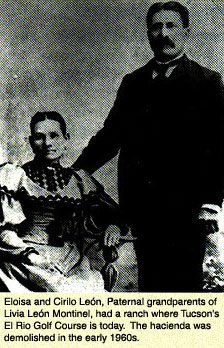from sonorensis, Volume 16, Number 1 (Spring 1996)
Patricia Preciado Martin
"Cuatro Milpas"
|
Cuatro milpas tan solo han quedado En ese rancho que era mío, Ay, ay, ay, ay. El portrero está sin ganado, La laguna se secó, Ay, ay, ay, ay. Y aquella casita, tan blanca y bonita Que triste que está. |
|
Four fields are all that remain Of that little ranch of mine, Ay, ay, ay, ay. The holding pens are empty of cattle, The lake has dried up, Ay, ay, ay, ay. And my little white house is so very sad and alone. |
Doña María Luisa Navarrette de Molina sang this popular Mexican ballad, "Cuatro Milpas," the night before she died peacefully in her sleep at the age of ninety in her mid-Tucson home. It was a significant and moving tribute to Dona Maria Luisa when this song, which extols a love for and attachment to la tierra, the land, and an abiding sadness at change and loss, was sung at her memorial mass by her family. It left nary a dry eye in the church, for this song expresses in a very personal and moving way not only the history and heritage of Dona Maria Luisa, but of many Mexican American families in Southern Arizona.

Dona Maria Luisa Navarrette de Molina was raised on her family ranch along the Rillito River and Sabino Canyon Road on what is now Tucson's congested east side. There she met and married Elias Molina whose family roots also grew deep along what was once a perennial cottonwood-shaded stream. They, like many other Mexican American families in southern Arizona, led a life of hard work, solitude and self subsistence in harmony with the land. It is difficult to imagine and appreciate the historical presence and economic and cultural contributions made by these pioneer families in the Sonoran Desert. But where there are now freeway interchanges and suburban housing tracts and shopping centers and golf courses, there were once vital and energetic and close knit communities of Hispanic settlers who brought with them the skills of living off the land from their native state of Sonora, as well as a legacy of Mexico's Native American, Spanish and Mestizo cultures.
Socorro Félix Delgado recalls living on her grandparents' ranch in the area of what is now the pecan groves of Sahuarita and Continental. The ranch and farm of Jesús and Andrea Arreola Félix was so large that it was registered at the post office and mail was delivered there. Socorro remembers the large fields of beans and corn and chile, the family vegetable garden with squash, tomatoes, onions and potatoes and herbs, and her grandmother's flower garden which provided fresh bouquets to decorate the family chapel when the priest would visit. Socorro's grandmother was steeped in the lore of Sonora and had extensive knowledge of the medicinal applications of native plants, roots and flowers. Dona Andrea used sauco, the flower from the tápiro or elderberry tea, to brew a tea that was good for stomach ailments. She also made teas for various ailments from a bark called negrita and hierba manzo and rose hips. Socorro still has as mementos some of the jars with the dried herbs in a china cabinet that belonged to her grandmother.
 Livia León Montiel traces her roots to a soldier of Tucson's Spanish presidio. Her great-grandfather, Solano León, was a member of the first territorial legislature and was known as a cattle baron because of his vast holdings in the Altar Valley. Sra. Montiel remembers with fondness their family's homestead in the community of Rillito close to the rapidly growing area of Marana. She remembers how her father built their comfortable ranch home of mud adobes and the many tasks that the family engaged in to keep the family ranch prospering: they made cheese from the milk of their dairy cattle and sold the surplus to the railroad station workers; they dried beef and filled their larder with sacks of carne seca which lasted them the whole year; they dried vegetables-tomatoes, chiles, squash and fruit. When they made tamales they used ingredients that were the product of their own labor-the meat, the corn and the chiles. Sra Montiel recalls the joys of desert life-the summer rains, the gathering of tunas (prickly pear fruit) with her great-grandmother Antonia Coronado, the making of candy from the barrel cactus. At Christmas, she remembers fondly, they cut a tamarisk tree and shaped it into a pine and decorated it with the fruit of the prickly pear and barrel cactus! Her mother, Antonia Galáz de Leon, an artistic and innovative woman, even made jewelry and sewing boxes from the shells of desert tortoises. Señora Livia León Montiel recounts that when large electric water pumps were brought to the area by corporate farms from the East the water table dropped and their ranch, which depended on windmills, had to be abandoned. It is ironic to realize that on the very site where their ranch once thrived is Breakers Water Park.
Livia León Montiel traces her roots to a soldier of Tucson's Spanish presidio. Her great-grandfather, Solano León, was a member of the first territorial legislature and was known as a cattle baron because of his vast holdings in the Altar Valley. Sra. Montiel remembers with fondness their family's homestead in the community of Rillito close to the rapidly growing area of Marana. She remembers how her father built their comfortable ranch home of mud adobes and the many tasks that the family engaged in to keep the family ranch prospering: they made cheese from the milk of their dairy cattle and sold the surplus to the railroad station workers; they dried beef and filled their larder with sacks of carne seca which lasted them the whole year; they dried vegetables-tomatoes, chiles, squash and fruit. When they made tamales they used ingredients that were the product of their own labor-the meat, the corn and the chiles. Sra Montiel recalls the joys of desert life-the summer rains, the gathering of tunas (prickly pear fruit) with her great-grandmother Antonia Coronado, the making of candy from the barrel cactus. At Christmas, she remembers fondly, they cut a tamarisk tree and shaped it into a pine and decorated it with the fruit of the prickly pear and barrel cactus! Her mother, Antonia Galáz de Leon, an artistic and innovative woman, even made jewelry and sewing boxes from the shells of desert tortoises. Señora Livia León Montiel recounts that when large electric water pumps were brought to the area by corporate farms from the East the water table dropped and their ranch, which depended on windmills, had to be abandoned. It is ironic to realize that on the very site where their ranch once thrived is Breakers Water Park.
The legacy of the Mexican American pioneers in the Sonoran desert is an enriching and enduring one. Although many of their monuments-their farms, ranches, chapels, homes and corrals-may have been bulldozed in the name of progress, it is important that we gather their stories and respect their memories and culture which has contributed so much and is still evident in the southwestern lifestyle that we cherish.
The song laments, "the lake has dried up" -let us make sure that our heritage does not blow away in the desert wind as well.
Patricia Presiado Martin is the author of El Milagro and Other Stories (University of Arizona Press, March 1996) and three other books on Mexican American topics.